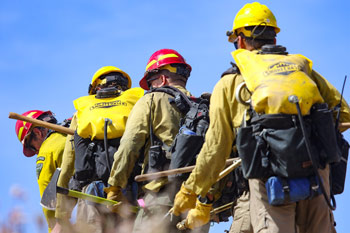Click Here for California Fires
September 2, 2024 - Today, about 14,239 wildland firefighters and support personnel are assigned to wildfires nationwide. As we head into September, 46 large active wildfires are being managed  with full suppression strategies. Current wildfires have burned 1,743,636 acres. Resources assigned to incidents include 20 complex incident management teams, 330 crews, 590 engines, and 91 helicopters.
with full suppression strategies. Current wildfires have burned 1,743,636 acres. Resources assigned to incidents include 20 complex incident management teams, 330 crews, 590 engines, and 91 helicopters.
Late summer and fall are characterized by extremely dry fuels in many parts of the country, and multiple geographic areas continue to fight fires that threaten homes and present major challenges to containment. As temperatures continue to climb in many areas, maintain heightened awareness of any possible sources of ignition.
Remember to always check for local fire restrictions before starting any outdoor activity. If fire restrictions are in place, respect them. By staying vigilant and making responsible choices, we can all help protect our communities and preserve our beautiful landscapes from devastating wildfires. Remember, it takes all of us to prevent wildfires.
Sixty fireline management personnel from Australia and New Zealand are assigned to support large fires in the Northwest Area. For more information about the mobilization of wildland firefighters from Australia and New Zealand visit the international support page.
Two hundred forty-five soldiers from the 14th Brigade Engineer Battalion and the 1st Battalion, 17th Infantry Regiment based out of Joint Base Lewis McChord (JBLM) are deployed in support of wildland fire operations on the Boise National Forest. NIMO (Team 2) is assigned to support the military contingent. To learn more about military mobilizations, visit the military support page.
Note: Given the very high tempo and scale of national fire activity over the past few months, there have been delays in reconciling actual acreage burned with entries into the reporting systems, especially from areas with large fires and dynamic fire activity. Adjustments are occurring as the accuracy of fire locations, mapping and final fire reporting is reconciled.
An upper-level low will move into Oregon, with isolated dry thunderstorms likely ongoing across eastern Oregon and moving into far west Idaho in the morning. Isolated to scattered mixed wet and dry thunderstorms will develop in the afternoon from the Oregon Cascades eastward into Idaho, with thunderstorms likely to continue overnight in northeast Oregon, central Idaho, and western Montana. Isolated mixed wet and dry thunderstorms will also develop in eastern Nevada into Utah and the West Slope. In addition, breezy and dry west to southwesterly winds of 15-30 mph with gusts 25-45 mph will develop in northeast California and much of Nevada as relative humidity falls as low as the single digits. The Southwest will turn drier today with any thunderstorms likely limited to southern New Mexico and far northern Arizona. Temperatures will also remain above normal in much of the West. Breezy southerly sustained winds around 20 mph with gusts to 35 mph amid relative humidity of 7-15% will develop on the central High Plains, from northeast Colorado into western South Dakota creating elevated to critical conditions. Moisture is expected to increase across much of Texas with scattered to widespread showers and thunderstorms. A cold front will move into the Southeast with mainly isolated thunderstorms, but cooler temperatures. Cool, but much drier air is forecast to move through much of the Great Lakes, Ohio Valley, and Northeast behind the front.
| Number of new large fires or emergency response * New fires are identified with an asterisk |
3 | States currently reporting large fires: |
| Total number of active large fires Total does not include individual fires within complexes. |
46 | |
| Acres from active fires | 1,743,636 | |
| Fires contained | 0 |
Year-to-date statistics
| 2024 (1/1/24-9/02/24) | Fires: 33,966 | Acres: 6,434,134 |
| 2023 (1/1/23-9/02/23) | Fires: 39,851 | Acres: 2,078,998 |
| 2022 (1/1/22-9/02/22) | Fires: 42,530 | Acres: 6,187,292 |
| 2021 (1/1/21-9/02/21) | Fires: 43,168 | Acres: 4,971,541 |
| 2020 (1/1/20-9/02/20) | Fires: 40,308 | Acres: 4,224,078 |
| 2019 (1/1/19-9/02/19) | Fires: 33,906 | Acres: 4,085,520 |
| 2018 (1/1/18-9/02/18) | Fires: 45,784 | Acres: 6,950,908 |
| 2017 (1/1/17-9/02/17) | Fires: 46,793 | Acres: 7,529,721 |
| 2016 (1/1/16-9/02/16) | Fires: 40,784 | Acres: 4,654,939 |
| 2015 (1/1/15-9/02/15) | Fires: 44,080 | Acres: 8,441,223 |
| 2014 (1/1/14-9/02/14) | Fires: 38,754 | Acres: 2,753,306 |
10-year average Year-to-Date
| 2014-2023 | Fires: 42,049 | Acres: 5,141,890 |
Source: NIFC








